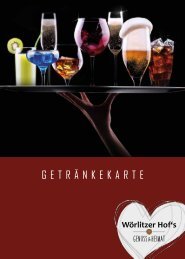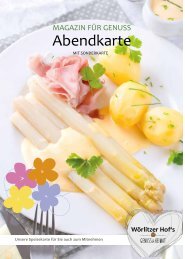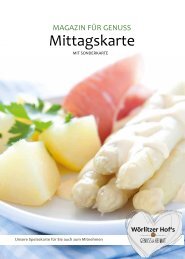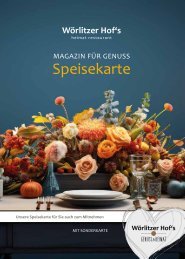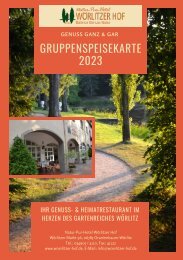Magazin Berchtesgaden
Create successful ePaper yourself
Turn your PDF publications into a flip-book with our unique Google optimized e-Paper software.
The Concept of the residence<br />
Access to the staterooms is through the main courtyard with its three-arched hallway, past<br />
the monumental niche with the Hercules fountain<br />
The imposing main staircase was constructed to give access to the princely staterooms.<br />
Ever since the time of Wolf Dietrich, the entrance was through<br />
the Carabinieri Hall, an impressive stateroom used for ceremonies and festivities that also<br />
gave access to the adjoining living and administrative quarters. The route which<br />
ambassadors, statesmen, and diplomats were required to take by Baroque ceremonial<br />
before an audience with the prince-archbishop led them through the Knights Hall to the<br />
Council Chamber, then passing through the Antechamber to the Audience Hall, the<br />
magnificent highlight. Only a few select guests were ever allowed access to the private<br />
area of the princely apartments adjacent to the study (Retirade). The order of these rooms<br />
was essentially laid down by the French suite of rooms for princely rituals and regulated by<br />
‘chamber ordinances’.<br />
The prince-archbishops continued to improve the décor of the Residenz. Therefore, the<br />
decoration of the Carabinieri Hall with stucco and ceiling frescoes dates from the time of<br />
Prince-archbishop Johann Ernst Graf von Thun.<br />
From 1709 Prince-archbishop Franz Anton von Harrach had the Residenz modernized. The<br />
renovation of the apartments, inspired by the Leopoldine Wing of the Imperial Palace in<br />
Vienna, was intended to emphasize the patron’s princely status as a prince-archbishop.<br />
The appearance of the main façade today, with its ornate main entrance portal and the<br />
stucco surrounding the windows of the piano nobile, origins from this era.<br />
Hieronymus Graf von Colloredo, the last prince archbishop before secularization, planned<br />
extensive changes to the buildings.<br />
He also commissioned Peter Pflauder, the court stucco artist, to decorate the walls of the<br />
staterooms with fine white and gold ornamentation in line with neoclassical taste.<br />
It was only with its transfer to the imperial crown estate office that the Residenz was used<br />
as a secondary residence by the Austrian imperial family. Consequently, the staterooms<br />
were equipped with furniture from the Imperial Furniture Collection.<br />
35





